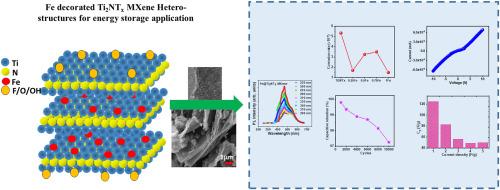Elevating electrochemical, electrical, anti-corrosion features and investigation of excitation dependent optoelectronic properties of binder free Fe decorated Ti2NTx MXene heterostructures
IF 4.9
3区 材料科学
Q2 CHEMISTRY, MULTIDISCIPLINARY
引用次数: 0
Abstract
Two-dimensional (2D) nitride MXenes are promising candidates for energy storage, corrosion protection, and optoelectronics, but their practical use is limited by layer restacking, structural instability, and insufficient active sites. Herein, we report the synthesis of binder-free Fe-decorated Ti2NTx MXene heterostructures via fluoride salt etching followed by in situ chemical reduction. Fe incorporation introduces redox-active centres (Fe2+/Fe3+, Fe/Fe2+), stabilises the MXene surface through Fe–Ti and Fe–N bonding, and alters the defect-state distribution responsible for excitation-dependent photoluminescence (PL). The optical band gap narrowed from 4.78 eV in Ti2AlN MAX to 3.7 eV in Ti2NTx MXene and was further tuned from 3.57 to 5.35 eV in Fe@Ti2NTx heterostructures. PL analysis confirmed the presence of shallow defect states (blue emission ∼470 nm) and deep-level defects (green/yellow emission ∼530–580 nm), with Fe decoration suppressing Al-related traps and stabilizing defect distributions across excitation wavelengths. X-ray photoelectron spectroscopy (XPS) deconvolution further confirmed the coexistence of Ti–N, Ti–O, Fe–Ti, Fe–Fe, and Fe–N bonding configurations, highlighting strong electronic interactions between Fe and the Ti2NTx host. The optimized 1 mM Fe@Ti2NTx electrode delivered a specific capacitance of 124.53 F/g at 1 A g−1 and 57.08 F/g at 0.005 V/s, with 97.25 % retention after 10,000 cycles. Corrosion current was reduced to 0.28 μA with a suppressed corrosion rate of 1.49 × 10−9 mm y−1 in 1 M H2SO4. These results establish Fe@Ti2NTx MXene as a multifunctional heterostructure with enhanced charge storage, durability, and defect-engineered optoelectronic response.

无粘结剂Fe修饰Ti2NTx MXene异质结构的电化学、电学、防腐特性及激发相关光电性能研究
二维(2D)氮化物MXenes是储能、防腐和光电子领域的有前途的候选者,但其实际应用受到层叠叠、结构不稳定和活性位点不足的限制。在此,我们报道了通过氟盐蚀刻和原位化学还原合成无粘结剂的fe修饰Ti2NTx MXene异质结构。Fe的掺入引入了氧化还原活性中心(Fe2+/Fe3+, Fe/Fe2+),通过Fe - ti和Fe - n键稳定了MXene表面,并改变了导致激发依赖性光致发光(PL)的缺陷态分布。光学带隙从Ti2AlN MAX中的4.78 eV缩小到Ti2NTx MXene中的3.7 eV,并在Fe@Ti2NTx异质结构中进一步从3.57 eV调谐到5.35 eV。PL分析证实存在浅缺陷态(蓝色发射~ 470 nm)和深缺陷态(绿色/黄色发射~ 530-580 nm), Fe修饰抑制了al相关陷阱并稳定了激发波长上的缺陷分布。x射线光电子能谱(XPS)反褶积进一步证实了Ti-N、Ti-O、Fe - ti、Fe - Fe和Fe - n键构型的共存,突出了Fe与Ti2NTx主体之间的强电子相互作用。优化后的1 mM Fe@Ti2NTx电极在1 a g−1时的比电容为124.53 F/g,在0.005 V/s时的比电容为57.08 F/g, 10000次循环后保持率为97.25%。在1 M H2SO4中,腐蚀电流降至0.28 μA,腐蚀抑制速率为1.49 × 10−9 mm y−1。这些结果证实Fe@Ti2NTx MXene是一种多功能异质结构,具有增强的电荷存储、耐久性和缺陷工程光电响应。
本文章由计算机程序翻译,如有差异,请以英文原文为准。
求助全文
约1分钟内获得全文
求助全文
来源期刊
CiteScore
7.80
自引率
2.50%
发文量
605
审稿时长
40 days
期刊介绍:
The Journal of Physics and Chemistry of Solids is a well-established international medium for publication of archival research in condensed matter and materials sciences. Areas of interest broadly include experimental and theoretical research on electronic, magnetic, spectroscopic and structural properties as well as the statistical mechanics and thermodynamics of materials. The focus is on gaining physical and chemical insight into the properties and potential applications of condensed matter systems.
Within the broad scope of the journal, beyond regular contributions, the editors have identified submissions in the following areas of physics and chemistry of solids to be of special current interest to the journal:
Low-dimensional systems
Exotic states of quantum electron matter including topological phases
Energy conversion and storage
Interfaces, nanoparticles and catalysts.

 求助内容:
求助内容: 应助结果提醒方式:
应助结果提醒方式:


